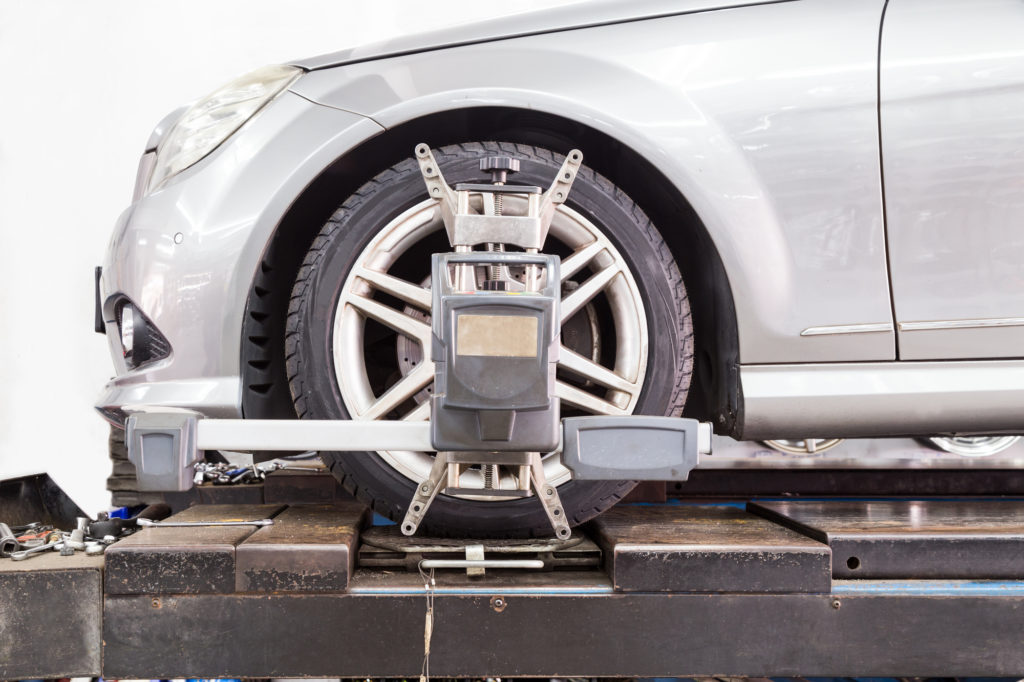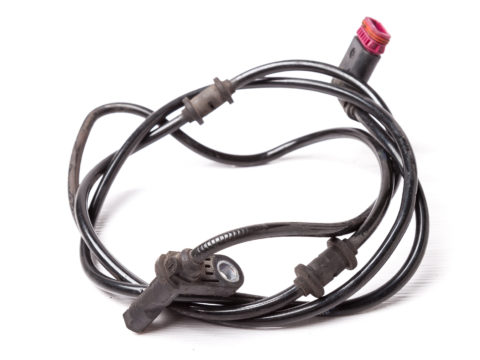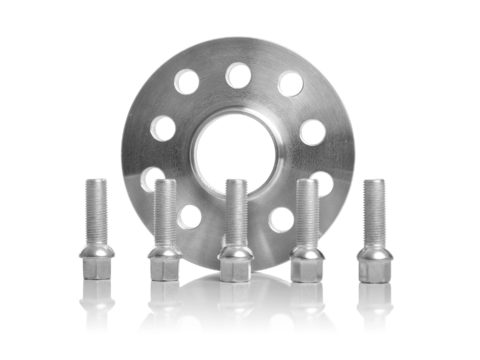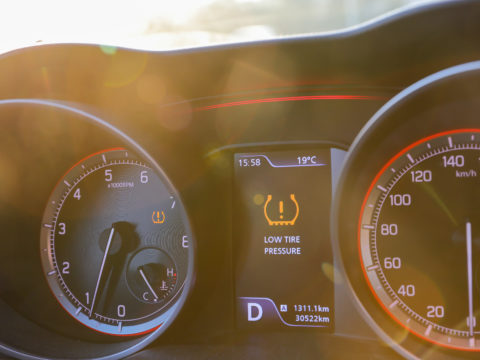Improper wheel alignment on your vehicle can cause a driving hazard to you and other drivers. If you suspect your vehicle has a poor alignment, you must get your vehicle inspected and don’t ignore the signs. Otherwise, an expensive fix or the need to replace your tires could be ahead.

Contents
What is Considered Bad Wheel Alignment?
Poor wheel alignment occurs when your wheels are not aligned with one another, resulting in a bumpy ride or difficulty steering. When your vehicle experiences poor alignment, your tires will wear unevenly since they are not working together with the proper friction levels. If you are experiencing signs of poor wheel alignment, it is vital to take your vehicle in for re-alignment.
What are the Signs of a Bad Alignment?
Most instances of poor alignment can be determined by how your steering wheel feels and reacts. Because improper alignment affects the wheels and the wheels are what you are controlling via the steering wheel, the best way to determine signs of poor alignment is to pay attention to your steering wheel.
However, there are also other determining factors that are signs of bad alignment.
1) Your Car Pulls to One Side
A simple and inexpensive way to test your wheel alignment is to let your vehicle pick where it wants to go. When driving down a straight road at slow speeds, take your hands off the steering wheel. If your car instantly pulls to one side or another, you likely have poor alignment. You can perform this test multiple times to ensure something is off.
2) Steering Wheel Is Not Even
When driving down a straight road, your steering wheel should remain straight and centered to your dash. If the steering wheel is not centered and you have to keep it turned to one side or the other to keep your vehicle straight on the road, your vehicle is most likely misaligned. The overcompensation you take to keep the car straight on the road reflects in the direction the steering wheel is facing.
3) Steering Wheel Has a Lot of Play In It
A steering wheel with lots of play is a sign of poor wheel alignment. The sloppy and loose steering wheel can increase the time needed to effectively make a turn. This increase may result in delayed turns and ineffective or dangerous driving.
4) Vibrating Steering Wheel
A vibrating steering wheel is a likely indicator of misalignment. If your steering wheel vibrates when you drive, your tires may be wearing unevenly, causing your ride to not be as smooth as it should. The uneven wear on your tires is caused by wheels that are not properly aligned.
5) Tires Wearing Unevenly
Tires that are wearing unevenly are a direct result of your tires not hitting the proper pressure points. This happens when your vehicle is misaligned as your tires take the brunt of the wear. Misalignment can also cause some tires to wear quicker than others.
To check if your tires are wearing unevenly, measure the tread depth on each side of all four tires. If one side is thicker than the other and each tire doesn’t match the others, it is time to schedule an alignment service. It is also vital to replace bad tires as they pose a severe driving hazard.
6) Squealing Tires
If you don’t have the time or aren’t confident in your ability to check the tread depth on your tires to determine if they are wearing unevenly, you can instead listen for squealing tires. If your tires are wearing unevenly, they may begin squealing when you accelerate or make turns, indicating it’s time for an alignment.
7) Bumpy Ride
Another key indicator that your vehicle has poor alignment is the smoothness of the ride. If you’re experiencing a bumpy ride, your wheel may be unevenly worn, which means it is likely time for a re-alignment.
What Causes Bad Wheel Alignment?
Bad wheel alignment can result in several varying instances. Anything from worn-out vehicle parts to heavy impact, low tire pressure, and even an overdue inspection can result in a misaligned vehicle.
1) Worn Parts
Worn-out car parts are a common cause of improper wheel alignment. If you have an older vehicle with extensive mileage, there may be parts on the vehicle that have not been upgraded and are beyond their expiration date. This can even become an issue on newer cars that are not maintained.
2) Heavy Impact
Perfect drivers do not exist. Even if you are an extremely careful driver, you are bound to hit something sitting in the roadway or another vehicle that may cause you to take a sharp turn and hit a curb. When these instances occur, it can cause a jarring effect on your vehicle. This sudden and unexpected jarring may result in an altered alignment.
3) Low Tire Pressure
An easy but vital vehicle component to check is your tire pressure. If your tires are not inflated to the tire recommendations, it can cause poor fuel efficiency, shorter vehicle lifespan, and cause your vehicle to become misaligned. The recommended PSI is printed directly on your tires and should receive a frequent inspection.
4) Bad Suspension
The suspension in a vehicle is there to create the necessary friction between the vehicle’s tires and the surface of the road. This friction creates a smoother ride for you and your passengers while generating more stable steering.
5) Overdue Re-Alignment
Unfortunately, even if you keep proper tire pressure and replace any worn parts, your vehicle may still need realignment. Why? The activity of simply driving your car can make it misaligned.
While it depends on the vehicle’s age and condition, recommendations suggest taking your car in for re-alignment at least once a year. This ensures your vehicle will perform better and last longer.

How Far Out of Alignment is Bad?
Alignment issues aren’t always sudden. It takes time for your wheels to become mis-aligned, which means that you may not notice it right away. While you can drive your vehicle if the alignment is bad, it is a good idea to fix your alignment as soon as you start noticing issues.
How to Check Wheel Alignment
The easiest way to check wheel alignment is to look at the car’s front tires. If the front tires are slightly pigeon-toed, your alignment is off. Similarly, you can view the front tires and inspect if the tires are toed-out. This also indicates your alignment is not correct. To make it more technical, you can check the vehicle’s owner’s manual to determine the exact measurements and angle of the tires to ensure where the proper alignment lines are.
How Long Does an Alignment Take?
The average time frame for a wheel alignment is one-hour. Factors that may affect this time frame are whether the vehicle is two or four-wheel drive and how off the alignment is. Mechanics may also inspect the suspension system, track rod, and steering bushing for any wear.
Can You Drive a Car With Bad Wheel Alignment?
In short, yes. You can drive a car with bad wheel alignment. If driving such a vehicle, it may be difficult to keep the car straight on the road or make left and right turns. You may also experience quicker and uneven wear on your tires if you have a bad wheel alignment.
Wheel Alignment FAQs
How much does an alignment cost?
If taking your vehicle in for an alignment, you can expect to pay anywhere from $65 to $100.
Should you get new tires after an alignment?
If trying to schedule a wheel alignment and new tire installation, you should install the new tires before getting the alignment. This ensures you get the most of your tires. It is counterintuitive to get new tires after an alignment.
How long will tires last with bad alignment?
If you have poor wheel alignment, your tires will likely wear out and need replacing after a few hundred miles.
Do I need an alignment after replacing tires?
Yes, it is vital to get an alignment after replacing your tires. This ensures you get the most life out of your tires, and they wear evenly.
How long can you drive without alignment?
It is recommended you take your vehicle at least once a year for a wheel alignment. However, if you are not experiencing any signs of misalignment, you can go longer without an alignment.














